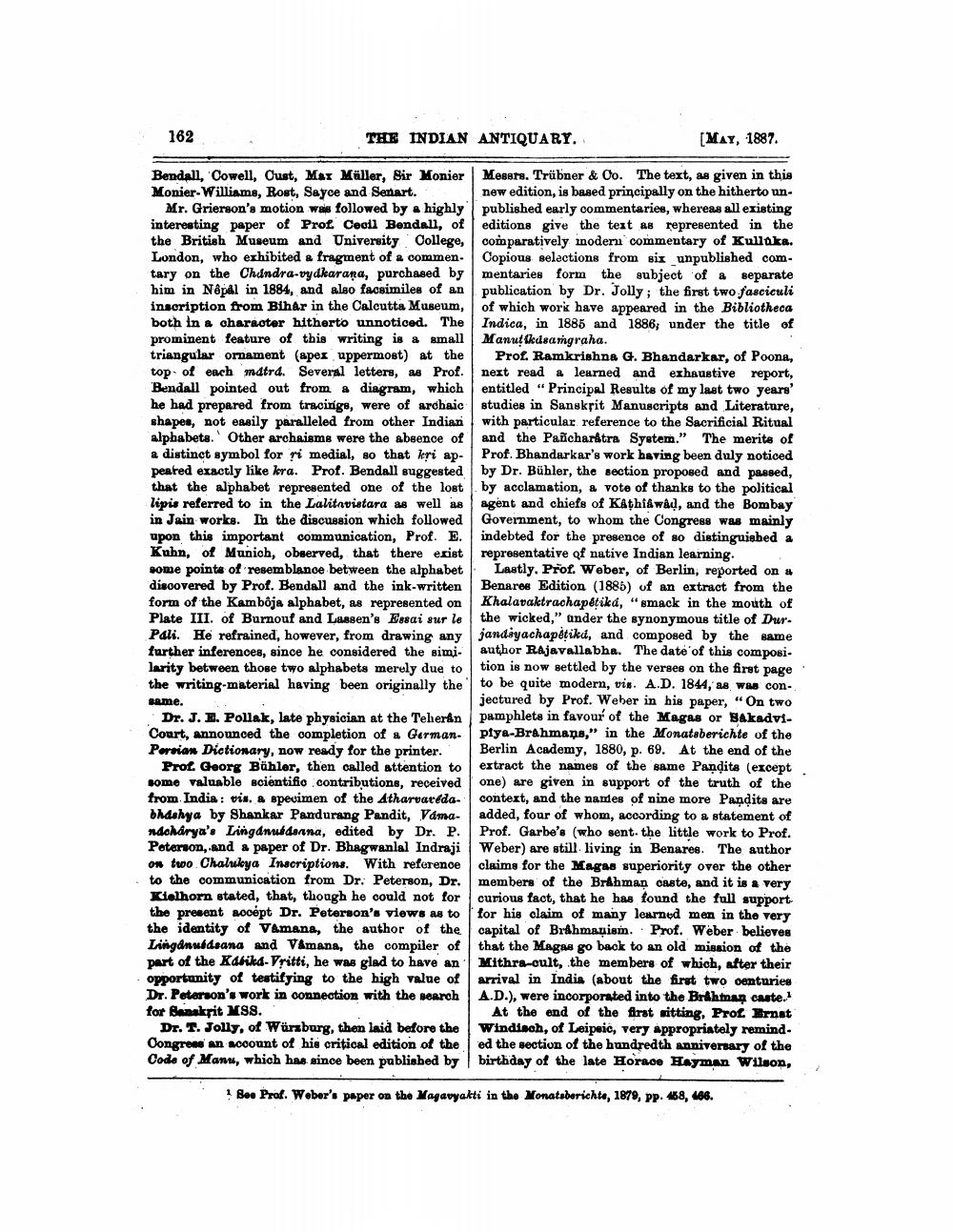________________
162
THE INDIAN ANTIQUARY.
[May, 1887.
Bendall, Cowell, Ouat, Mar Müller, Sir Monier Messrs. Trübner & Co. The text, as given in this Monier-Williams, Rost, Sayee and Senart.
new edition, is based principally on the hitherto un. Mr. Grierson's motion was followed by a highly published early commentaries, whereas all existing interesting paper of Prof Cecil Bendall, of editions give the text as represented in the the British Museum and University College, comparatively inodern commentary of Kullaka. London, who exhibited a fragment of a commen. Copious selections from six unpublished comtary on the Chandra-vydkarana, purchased by mentaries form the subject of a separate him in Nepal in 1884, and also facsimiles of an publication by Dr. Jolly; the first two fasciculi inscription from Bihar in the Calcutta Museum, of which work have appeared in the Bibliotheca both in a character hitherto unnoticed. The Indica, in 1885 and 1886; under the title of prominent feature of this writing is a small Manut/kdsangraha. triangular ornament (apex uppermost) at the Prof. Ramkrishna G. Bhandarkar, of Poona, top of each matrd. Several letters, as Prof. next read a learned and exhaustive report, Bendall pointed out from a diagram, which entitled "Principal Results of my last two years' he had prepared from tracings, were of archaic studies in Sanskrit Manuscripts and Literature, shapes, not easily paralleled from other Indian with particular reference to the Sacrificial Ritual alphabets. Other archaiems were the absence of and the Pancharstra System.” The merits of a distinct symbol for ri medial, so that keri ap- Prof. Bhandarkar's work having been duly noticed peared exactly like kera. Prof. Bendall suggested by Dr. Bühler, the section proposed and passed, that the alphabet represented one of the lost by acclamation, a vote of thanks to the political lipis referred to in the Lalitnvistara as well as agent and chiefs of Kathiawad, and the Bombay in Jain works. In the discussion which followed Government, to whom the Congress was mainly upon this important communication, Prof. E. indebted for the presence of so distinguished a Kuhn, of Munich, observed, that there exist representative of native Indian learning. some points of resemblance between the alphabet Lastly. Prof. Weber, of Berlin, reported on a discovered by Prof. Bendall and the ink-written Benares Edition (1886) of an extract from the form of the Kamboja alphabet, as represented on Khalavaktrachapéţika, “smack in the mouth of Plate III. of Burnouf and Lassen's Essai sur le the wicked," under the synonymous title of Dur. Pali. He refrained, however, from drawing any jandayachapétiká, and composed by the same further inferences, since he considered the simi. author Rajavallabha. The date of this composi. larity between those two alphabets merely due to tion is now settled by the verses on the first page the writing material having been originally the to be quite modern, vis. A.D. 1844, as was conse.me. .
jectured by Prof. Weber in his paper, “On two Dr. J. E. Pollak, late physician at the Teheran pamphlets in favour of the Magas or Bakadvi. Court, announced the completion of a German- piya-Brahmans," in the Monatsberichte of the Persian Dictionary, now ready for the printer. Berlin Academy, 1880, p. 69. At the end of the
Prof. Georg Bühler, then called attention to extract the names of the same Pandita (except some valuable scientifio contributions, received one) are given in support of the truth of the from India: vis. a specimen of the Atharvareda. context, and the names of nine more Pandits are bhashya by Shankar Pandurang Pandit, Vama. added, four of whom, according to a statement of ndcharya's Lingdnubdanna, edited by Dr. P. Prof. Garbe's (who sent the little work to Prof. Peterson, and a paper of Dr. Bhagwanlal Indraji Weber) are still living in Benares. The author on two Chalukya Inscriptions. With reference claims for the Magas superiority over the other to the communication from Dr. Peterson, Dr. members of the Brahman caste, and it is a very Kielhorn stated, that, though he could not for curious fact, that he has found the full support the present accept Dr. Peterson's views as to for his claim of many learned men in the very the identity of Vamana, the author of the capital of Brahmanism. Prof. Weber believes Lingánu doana and Vamana, the compiler of that the Magas go back to an old mission of the part of the Karika-Vritti, he was glad to have an Mithra-cult, the members of which, after their opportunity of testifying to the high value of arrival in India (about the first two centuries Dr. Peterson's work in connection with the search A.D.), were incorporated into the Brahman caste. for Sanskrit XSS.
At the end of the first sitting, Prol krnat Dr. T. Jolly, of Würzburg, then laid before the Windisch, of Leipeic, very appropriately remind. Congress an account of his critical edition of the ed the section of the hundredth anniversary of the Code of Man, which has since been published by birthday of the late Horace Hayman Wilson,
! See Prof. Weber's paper on the Magavyakti in the Monatsberichte, 1879, pp. 158, 166.




